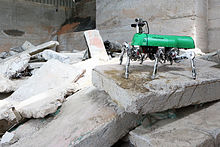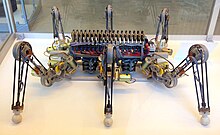Lauron (robot)
Lauron ( spelling LAURON ) is a six-legged walking robot developed by Forschungszentrum Informatik Karlsruhe (FZI) . The Indian stick insect served as a biological model for the mechanics and motion control . The Lauron series began with investigations into six-legged running and in 1994 led to the first walking robot Lauron, which was presented to the public at CeBIT in Hanover. From this first generation, which, in contrast to the current generation, was still controlled with neural networks , the name derives from “ LAU fender RO boter N euronal controlled”. The current generation Lauron V was completed in 2013.
overview
This walking robot was developed to explore statically stable running in rough terrain. Thanks to the flexible behavior-based control, Lauron can adapt to unknown situations. The mechanical structure and the different running and movement options enable stable locomotion even in extreme situations. A panorama camera was mounted on the robot for user-supported control. In this way, the operator has an overview of the robot and its surroundings. By using augmented reality glasses, the operator is shown further information about the robot status in addition to the camera image.
Lauron can independently perceive his surroundings and plan the way to a specified destination. While running, the robot can use sensors to detect possible obstacles in order to either climb over or avoid them. The walking machine is suitable for inspection and service tasks in unstructured, impassable or dangerous terrain, e.g. B. when clearing landmines , exploring volcanoes or looking for people buried as a result of natural disasters.
Generations
Insect (from approx. 1992)
In the 1990s, the Lauron project initially produced a few prototypes. In 1992 Insect , a wooden prototype of a six-legged walking machine, was manufactured at the Informatics Research Center (FZI) at the Karlsruhe Institute of Technology . He did not have any actuators, but was able to determine the joint angles of his legs using potentiometers .
Lauron I (from around 1994)
Lauron I was built in late 1993 and presented to the public at CeBIT in 1994. It consisted of aluminum for the central body and fiber-reinforced plastic for the legs and weighed approx. 11 kg. The robot was controlled with neural networks. The relationship between the leg segments was designed similarly to that of the stick insect Carausius Morosus .
Lauron II (from around 1995)
At the end of 1994 the second generation of Lauron was developed. It was characterized by a modified design and additional sensors, such as foot force and inclination sensors. The heavier legs, which were now made of aluminum, increased the weight to 16 kg. Lauron II was used as a test platform for various control strategies and for machine learning .
Lauron III (from approx. 1999)
In 1999 the third Lauron generation was constructed. With a weight of 18 kg, the robot was able to carry up to 10 kg of additional load. The neural networks that were used for control in the previous Lauron versions have been replaced by a modular, reactive robot controller in Lauron III. In addition to walking itself, the robot has now also been used to research new areas such as localization , navigation and environmental modeling. In the years that followed, eight Lauron III robotic systems were built and sold.
Lauron IV (from around 2004)
The fourth generation of Lauron was developed in 2004. The mechanical construction has been improved compared to the previous model with regard to robustness. The cables in the legs were replaced by toothed belts and a new head with two degrees of freedom was attached. The central body was made of carbon fiber reinforced plastic . Lauron IV weighs 27 kg and can run at speeds of up to 0.22 m / s. Microcontrollers , which were previously used for control, have been replaced with two embedded PCs and special motor control electronics at Lauron IV . Furthermore, NiMH batteries have been integrated with which the robot can be operated for up to 60 minutes. The current version of the walking robot is Lauron IVc. It was completed in late 2005 and has minor mechanical improvements in the legs and minor hardware changes over the previous versions. The behavior-based robot control reacts quickly to obstacles and uneven terrain and allows you to move safely even in unstructured terrain. Three walking robots of this generation were put into operation. The IVc version has been in use at the FZI since around 2005.
Lauron V (from approx. 2013)
The fifth generation was presented at the international robotics conference IEEE ICRA in summer 2013. Lauron V is characterized above all by an additional rotary joint. It increases the working space of each leg, enables the orientation of the foot to be specified in relation to the ground and enables objects to be grasped and manipulated with the front legs. The kinematic structure is based even more on the biological model and ensures safe locomotion. Lauron V should be used for demanding inspection and search and rescue tasks.
Lauron V took the Spacebot Cup of DLR in part, the first competition at the International Aerospace Exhibition was opened in Berlin 2012th At the competition in Rheinbreitbach in autumn 2013, a faulty cable contact with the foot sensor and an integration error between software components caused Lauron V to stop and switch to a motor safety mode that could be perceived as the robot moving up and down.
literature
- Bernd Gaßmann: Model-based, sensor-supported navigation of running machines in the field . Kit Scientific Publishing, 2007, ISBN 978-3-86644-119-4 .
- Rüdiger Dillmann, Jürgen Beyerer, Christoph Stiller: Autonomous Mobile Systems 2009: 21st Expert Discussion Karlsruhe, 3./4. December 2009 (Informatik Aktuell) . Springer, 2009, ISBN 978-3-642-10283-7 .
Web links
- Project Lauron IVc ( Memento from July 8, 2013 in the web archive archive.today ) - page at the FZI Research Center for Computer Science at the Karlsruhe Institute of Technology
- Lauron IVc - runs through difficult terrain on YouTube
- The 2011 award winner. (PDF, 743 kB) Faulhaber Info, 2011, pp. 14–15 , accessed on July 12, 2011 .
Individual evidence
- ↑ FZI / Research / Lauron. Retrieved November 12, 2017 .
- ↑ Martin Zeuch: Bionics (= What is what? Volume 122 ). Tessloff Verlag, Nuremberg 2006, ISBN 3-7886-1509-5 , p. 43 .
- ^ Roland Franik, Ulrich Klose: Workbook Natural Science and Technology Baden-Württemberg . 1st edition. Duden Paetec GmbH, Berlin 2007, ISBN 978-3-89818-398-7 , p. 206 .
- ↑ Walking Robot LAURON V - Search and Rescue on YouTube
- ^ FZI: Results of the SpaceBot Cup. December 10, 2013, accessed May 3, 2014.


